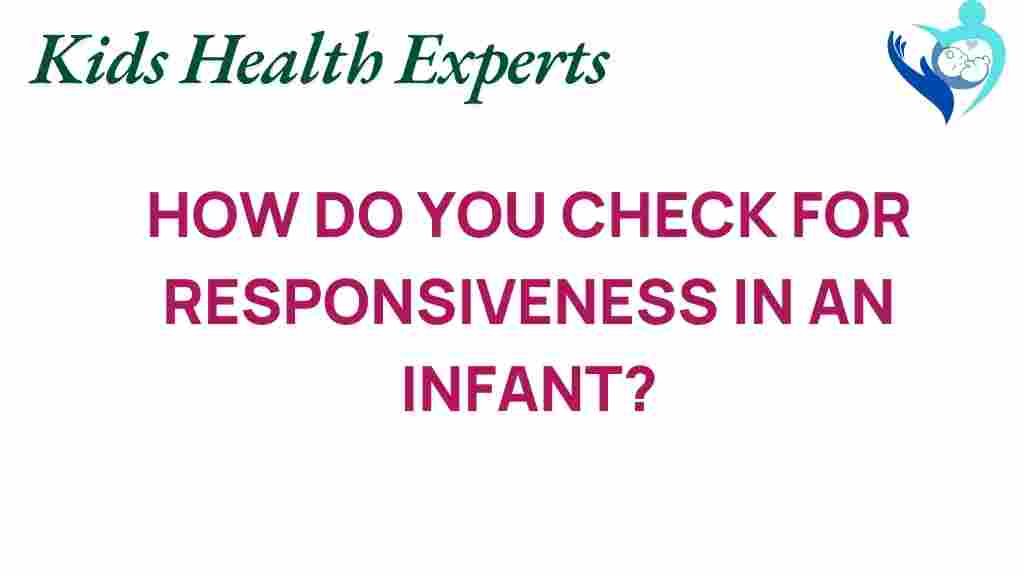Unlocking the Secrets: How to Check for Responsiveness in Infants
As parents, one of the most important aspects of caring for your little one is understanding their development and ensuring their health. One key element in child development is infant responsiveness. This term refers to how well your baby responds to stimuli, interacts with their environment, and engages with caregivers. By learning how to assess your infant’s responsiveness, you can better support their growth and development. This article will guide you through the process of checking for infant responsiveness, offer tips for parental guidance, and provide insights into early signs of healthy development.
Understanding Infant Responsiveness
Infant responsiveness is crucial in determining how well your baby is developing socially, emotionally, and cognitively. Responsive behavior includes:
- Eye contact
- Smiling or cooing in response to interactions
- Following sounds or movements with their eyes
- Showing interest in toys or people
- Reacting to their name or familiar voices
By monitoring these behaviors, parents can gain insight into their child’s developmental milestones and overall health. Regular infant assessments are essential during the early stages of growth.
Step-by-Step Process to Check for Responsiveness
Here’s how you can conduct a simple check for your infant’s responsiveness:
1. Create a Calm Environment
Start by ensuring your baby is in a calm and comfortable environment. Minimize distractions and noise to help them focus on you. A quiet room with soft lighting works best.
2. Engage in Eye Contact
Hold your baby close and make direct eye contact. Observe if they maintain eye contact with you. This is one of the first signs of responsive behavior.
3. Use Sounds and Voices
Make different sounds—coo, clap your hands, or sing softly. Notice if your baby turns their head or eyes toward the sound. This behavior indicates that they are engaged and responsive.
4. Introduce Toys or Objects
Show your baby a colorful toy or object. Move it slowly from side to side and observe if they follow it with their eyes. Responsive infants will track objects with their gaze.
5. Encourage Interaction
Encourage your baby to respond by smiling, talking, or making funny faces. Wait for their reaction. Do they smile back or make sounds? These are positive signs of engagement.
6. Observe Reactions to Emotions
Express different emotions (happiness, surprise, etc.) and watch for your baby’s reaction. Babies often mirror emotions, so a responsive baby will likely show similar feelings.
7. Monitor Social Engagement
Look for signs of social engagement, such as your baby reaching out for you or responding when you call their name. This indicates they are developing social skills.
8. Check for Physical Responses
Observe your baby’s physical reactions. Do they kick their legs or show excitement when they see you? These movements can indicate satisfaction and responsiveness.
9. Document Your Observations
Keep a record of your findings. Note any patterns in your baby’s behavior over time, which can be helpful during health checks with your pediatrician.
Troubleshooting Tips
If you notice signs of unresponsiveness or if your baby does not engage as expected, consider the following:
- Consult with a Pediatrician: If your baby consistently shows unresponsive behavior, it may be time for a professional evaluation. Early detection can lead to better outcomes.
- Assess Health Check-ups: Ensure your baby is up to date with health check-ups. Regular visits to a pediatrician are crucial for monitoring developmental milestones.
- Consider Environmental Factors: Sometimes, external factors such as illness, lack of sleep, or overstimulation can affect responsiveness. Ensure your baby is healthy and comfortable.
- Engage with Caregivers: If you’re concerned about your baby’s responsiveness, involve other caregivers in the assessment process. Different perspectives can provide valuable insights.
Conclusion
Understanding and checking for infant responsiveness is an essential part of baby care and child development. By learning to observe and engage with your baby, you can support their growth and ensure they are developing healthily. Remember that every baby develops at their own pace, and being proactive in monitoring their responsiveness will help you identify any potential concerns early on. For more information on infant assessments and pediatric health, consult your healthcare provider or visit reputable resources like the American Academy of Pediatrics.
By staying informed and engaged, you can foster a nurturing environment that promotes your baby’s responsive behavior and overall well-being. Don’t hesitate to reach out for support and utilize resources available to you as a parent.
This article is in the category Care and created by KidsHealthExperts Team
